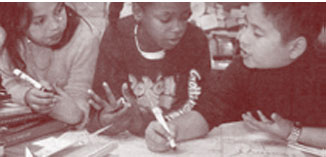



Roosevelt Elementary School: Climate and Culture Changes
Long Beach, California
During this initial phase of training, I was impressed by the rapid, contagious nature of the spreading of these tools. The Thinking Maps kept "bobbing up" into other classrooms, even though not all teachers got trained immediately. It appeared that teachers were sharing ideas in the lounge, during grade-level meetings, wherever they met. Teachers actually met on their own time to talk about professional concepts.
I realized that one of the unplanned benefits was that because Thinking Maps were so easy to implement, they could easily become the topic of professional talk. This occurred not only between pairs of teachers, but between teachers who rarely had occasion to share ideas, such as a kindergarten teacher and a third-grade teacher. Suddenly, teachers had a first language for thinking in which to talk about student learning, one that was not dependent on grade level or content area.
Another change that occurred was that the teachers realized that the culture of the school was going to be one in which lifelong learning was not reserved just for students. The expectation was that teachers should be learning new strategies that help accelerate student achievement and that "doing things as we've always done them" was no longer acceptable. The difference between learning the maps and participating in other staff development was that these tools emulated adult thinking and strategies. These were then shared with students. Thus, the strategies were authentic. Rather than teachers learning a "canned program" that did not reflect what they as adults did and did not give them what their students needed, teachers were learning lifelong strategies for themselves and then teaching them to their students. As teachers began to experiment with the Thinking Maps in their own lives-such as making Tree Map shopping lists-they developed into the learning community that I was trying to foster at my school, but never expected to get from these tools.
Another benefit I was surprised and pleased to see was that new teachers could participate in the discussions about high-quality tools as equals. The visual language and the common vocabulary was not a mysteriously complex formula that creates a wall between veteran teachers who have internalized a thoroughly unique and idiosyncratic teaching style and the new teachers and instructional aides who are just learning the ropes. With a common language, veteran teachers could model expert applications along a continuum-one rope-that novice teachers could easily grab onto and make their own (see Chapter 16, Mentoring Mathematics Teaching and Learning).
More information about Roosevelt Elementary School is part of the book Student Successes With Thinking Maps — read excerpts from this chapter and other chapters about the student successes.